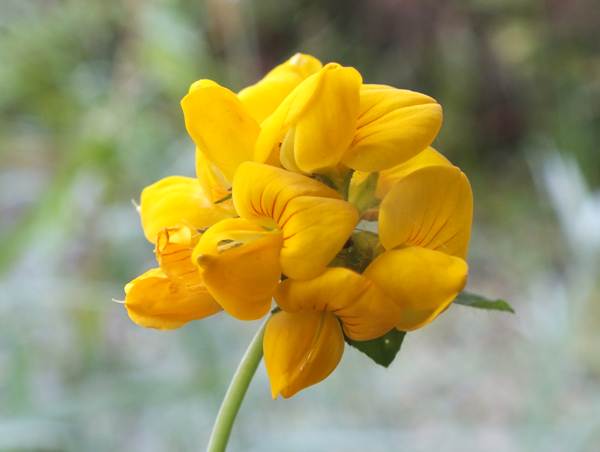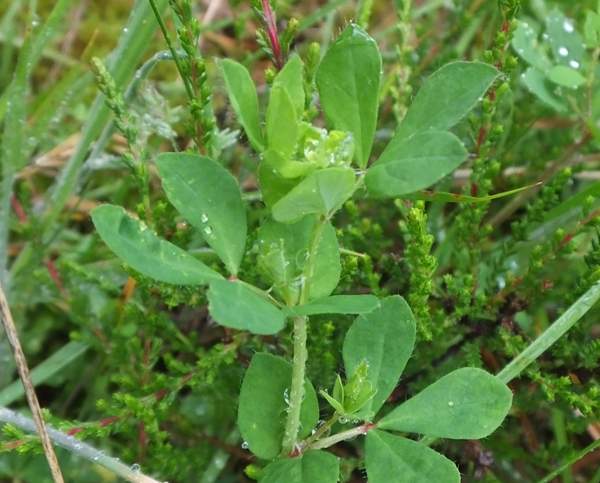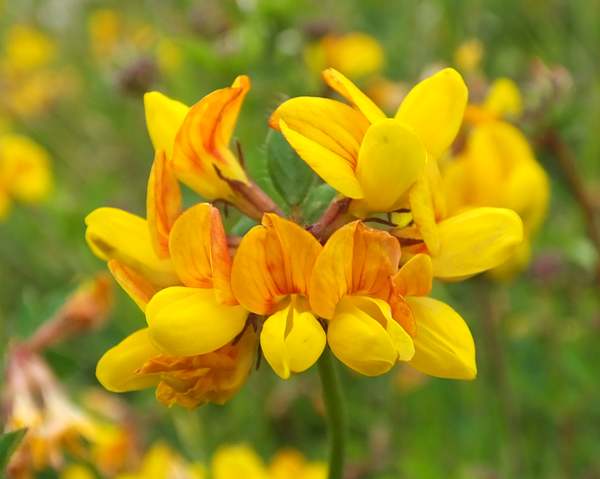Lotus pedunculatus - Greater Bird's-foot Trefoil
Phylum: Magnoliophyta - Class: Equisetopsida - Order: Fabales - Family: Fabaceae

This tallish member of the Pea family grows in damp grassland habitats. The flowers could be mistaken for Meadow Vetchling, but the absence of tendrils plus the roundish leaf blades readily separate this Lotus species from the various yellow Lathyrus species.
Description
An perennial and usually hairy plant of damp grassland, Lotus pedunculatus typically grows to a height of between 30 and 50cm. Its clusters of bright-yellow (or sometimes yellow tinged with orange) pea-like flowers are very similar to those of Common Bird's-foot Trefoil, Lotus corniculatus; however, Greater Bird's-foot Trefoil has clusters of as many as 12 individual flowers and hollow stems, whereas Common Bird's-foot Trefoil has 3 to 7 flowers in individual clusters on each solid stem. Individual flowers are 10-12 mm long and are carried in racemes on erect stems. Each flower has five petals, although that is not immediately obvious; one petals stands upright, two more form the wings, and a further two smaller petals are united to form what is known as a keel.
The pinnate leaves have five leaflets which are dark bluish green on top and greyish beneath. (Stems are hollow, not solid, and this is an important identifying feature.)

As with other members of the family Fabaceae, seed pods of Greater Bird's-foot Trefoil are long and narrow, held in bunches that look (so it has been suggested) rather like the clawed feet of birds. Each pod holds several seeds (peas, of course!), and as they dry the pods twist and then split to release their seeds.
Distribution
Common throughout Britain and Ireland, Greater Bird's-foot Trefoil can be found throughout most of mainland Europe. This member of the Pea family has also been introduced to many other temperate parts of the world.

Habitat
Greater Bird's-foot Trefoil is found in all sorts of wet grassland, including ditches, wet permanent pastures, bogs and marshes. It is most commonly seen in areas where the soil is acidic.
Blooming Times
The first flowers of Greater Bird's-foot Trefoil usually appear in late May or early June, and blooming continues until the end of August.
Etymology
Lotus, the genus name, may come from a Greek word, but it refers to an entirely different plant! The specific epithet pedunculatus comes from Latin and means 'with a stalk'.
Similar Species
Common Bird's-foot Trefoil Lotus corniculatus is shorter and grows in dry grassland. Its stems are solid whereas the stems of Lotus pedunculatus are hollow.
The photographs of Greater Bird's-foot Trefoil shown on this page were taken in Wales during late June.
Sue Parker's latest ebook is a revised and enlarged second edition of the acclaimed Wildflowers in the Algarve - an introductory guide. Full details here...
Buy it for just £3.95 on Amazon...
Please Help Us: If you have found this information interesting and useful, please consider helping to keep First Nature online by making a small donation towards the web hosting and internet costs.
Any donations over and above the essential running costs will help support the conservation work of Plantlife, the Rivers Trust and charitable botanic gardens - as do author royalties and publisher proceeds from books by Pat and Sue.



